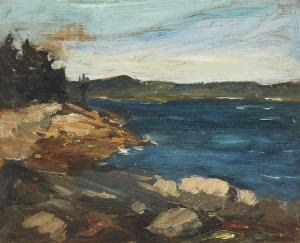I have just returned from a painting trip to Maine. I was graciously hosted at the family home of a good painting buddy. She invited three other painters to join her for the week's adventure. We had great weather, and there was no shortage of painting motifs. I think I could stay on Bailey Island for months--or years--and still not tire of painting there.
 |
| "Across Linekin Bay, Maine" Oil on Panel, 8 x 9 3/4 Robert Henri, 1903 |
Maine has attracted more than its share of artists through the years, Edward Hopper spent nine summers painting in Maine, early in his career. His luscious landscapes from that period are a wonder to behold, and are a far cry from his later urban scenes. If you enjoy such things, the Wall Street Journal just published an article










